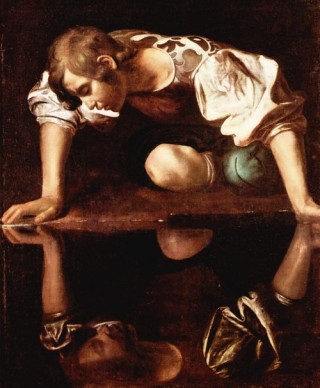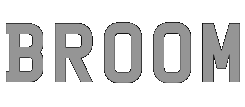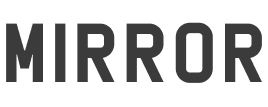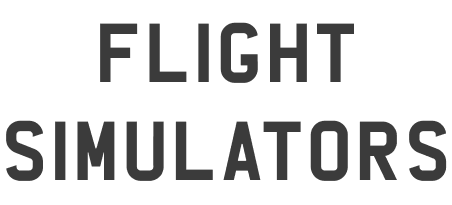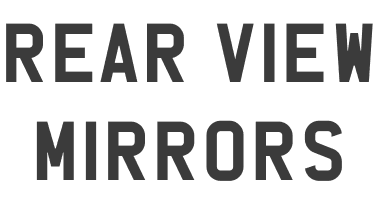- Manufacturer: Established & Sons
- Designer: Sebastian Wrong
- Material: polymer, glass, steel
- Dimensions: 90 × 30 × 3
- www.establishedandsons.com
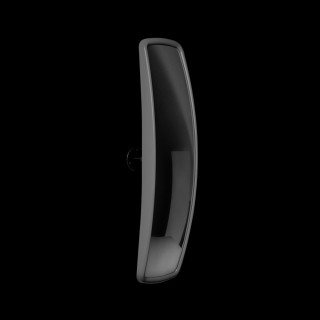
The Convex Mirror is designed with humour and with the ambition of creating an ultimately functional object. The mirror allows its owner the opportunity to select any reflection they choose because of its ability to rotate and move on any axis. This smooth movement is made possible by a ball joint at the rear of the mirror. The convex curve of the mirror surface is manufactured using instrument quality mirror technology normally reserved for use in aircraft simulators. The mirror is finished with a tactile precision injection moulded casing. Sebastian Wrong has taken inspiration from an everyday automotive mirror.
Index
- Sebastian Wrong Sebastian Wrong was born in 1971 in London and he studied BA Hons in Fine Art (sculpture) Norwich School of Art and Camberwell School of Art, graduate
- Established and Sons Established & Sons is a design and manufacturing company at the vanguard of the furniture industry, we strive to prompt debate and instigate developme
- Convex Mirrors A curved mirror is a mirror with a curved reflective surface, which may be either convex (bulging outward) or concave (bulging inward). Most curved mi
- Flight Simulators "In 1982 the Rediffusion company of Crawley, UK, introduced the Wide-angle Infinity Display Equipment (WIDE) that used a curved mirror of large horizo
- Rear View Mirrors The rear-view mirror's earliest known use and mention is by Dorothy Levitt in her 1906 book The Woman and the Car which noted that women should "carry
- Marcel Duchamp Marcel Duchamp (28 July 1887 – 2 October 1968; French pronunciation: [maʀsɛl dyˈʃɑ̃]) was a French/American artist whose work is most often associated
- Re-Sized Readymades Pratone Design: G. Ceretti, P. Derossi, R. Rosso Date: 1971 Manufacturer: Gufram Materials: Cold foamed polyurethane treated with green washble paint
- Mirror History The first mirrors used by people were most likely pools of dark, still water, or water collected in a primitive vessel of some sort. The earliest manu
- Related Media This wall mounted mirror is engineered to rotate and move on any axis and present a near perfect reflection. A lever and ball joint at the back of the
- Others Applications Sun catcher A CSP station consists of banks of several hundred giant mirrors that cover large areas of land, around a square kilometre. Each mirror's
- Superstition The humble mirror is probably the focus of more superstitions than any other object. These stories evolved from the times when water was used as a mir
- Narcissus Narcissus or Narkissos (Greek: Νάρκισσος), possibly derived from ναρκη (narke) meaning "sleep, numbness," in Greek mythology was a hero from the terri
Sebastian Wrong was born in 1971 in London and he studied BA Hons in Fine Art (sculpture) Norwich School of Art and Camberwell School of Art, graduated in 1993. His education has been in the field of three dimensional art, and his design practice has developed as parallel work with fine art. His interests are in material manipulation, purity of form, function and honesty. The design work cultivates from the balance between function, aesthetics and refinement. For Sebastian Wrong, ten years within the manufacturing sector has accumulated in an impressive array of technical skills. Wrong studied sculpture before establishing his own successful manufacturing company in 1995. The 'Spun' lamp, made a huge impact when first exhibited internationally in 2002, it has since won the prestigious Red Dot design award and is currently being produced by Flos. Together with Mark Holmes Wrong formed the multifaceted creative organisation 'The Lane' in 2003 that produced a collection of design products, graphic identities and exhibition designs. Wrong is also a founding member and director of Established & Sons. His manufacturing prowess has lent substantial credibility to the organisation and he continues to exercise his abilities as a product designer. Wrong is active in the operational management and prototype developments of Established & Sons.
Established & Sons is a design and manufacturing company at the vanguard of the furniture industry, we strive to prompt debate and instigate development and progress in everything we do. From the onset, Established & Sons has been dedicated to reviving interest in Britain's ailing manufacturing industry through the production of the highest quality products. The designers we work with are British or British-based and all of the development and manufacturing of our products takes place in the UK.A unique method of collaboration and commissioning has come to characterise Established & Sons work. (...)
Since the international launch of Established & Sons in 2005 the company's swift and successful growth has been recognised worldwide. A tireless program of events and exhibitions has seen three major shows during the Milan Salone del Mobile plus launches in London, Tokyo, Paris and New York. (...)
The Established & Sons collection is currently divided into three parts; our substantial and growing Collection of production furniture designs, 'Limited' a collection of extraordinary designs produced in limited editions using the finest manufacturing techniques and designed by the most significant contemporary creatives and 'Collaborations' a programme of work that puts individuals from the art, design, architecture and other creative disciplines together in the production of experimental and original designs.
A curved mirror is a mirror with a curved reflective surface, which may be either convex (bulging outward) or concave (bulging inward). Most curved mirrors have surfaces that are shaped like part of a sphere, but other shapes are sometimes used in optical devices. The most common non-spherical type are parabolic reflectors, found in optical devices such as reflecting telescopes that need to image distant objects, since spherical mirror systems suffer from spherical aberration.
A convex mirror, fish eye mirror or diverging mirror, is a curved mirror in which the reflective surface bulges toward the light source. Convex mirrors reflect light outwards, therefore they are not used to focus light. Such mirrors always form a virtual image, since the focus F and the centre of curvature 2F are both imaginary points "inside" the mirror, which cannot be reached. Therefore images formed by these mirrors cannot be taken on screen. (As they are inside the mirror) A collimated (parallel) beam of light diverges (spreads out) after reflection from a convex mirror, since the normal to the surface differs with each spot on the mirror.
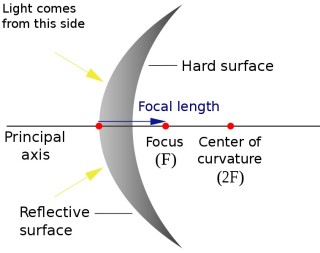
Convex parking mirror
- Relief from parking accidents in the garage.
- Confidence to back out without hazard.
- Mount inside or outside of the garage right on the wall.
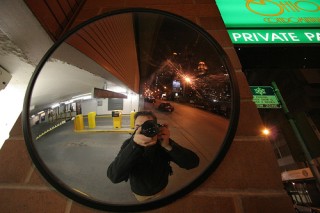
"In 1982 the Rediffusion company of Crawley, UK, introduced the Wide-angle Infinity Display Equipment (WIDE) that used a curved mirror of large horizontal extent to allow distant-focus (collimated) viewing by side-by-side pilots in a seamless display. WIDE-type displays are now universal in the highest levels of Full Flight Simulators for aircraft where two pilots are seated side-by-side."
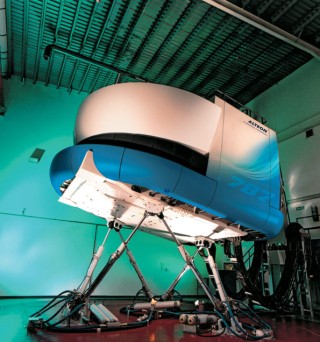
- en.wikipedia.org/wiki/Flight_simulator
- www.boeing.com/commercial/aeromagazine/articles/qtr_1_08/images/photo_02_2.jpg
Collaminated Mirror
The collaminated principle is used in Full Flight Simulators (FFS), that have specially designed systems for displaying imagery of the Outside World (OTW) to the pilots in the replica aircraft cabin. In aircraft where two pilots are seated side by side, if the OTW imagery were projected in front of the pilots on a screen, one pilot would see the correct view but the other would see a distorted view where some objects in the scene would be at incorrect angles. To avoid this, collimated optics are used in the simulator visual display system so that the OTW scene is seen by both pilots at a distant focus rather than at the focal length of a projection screen.
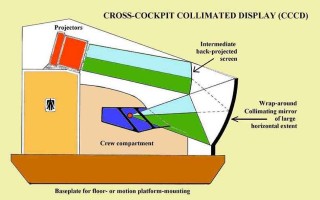
The rear-view mirror's earliest known use and mention is by Dorothy Levitt in her 1906 book The Woman and the Car which noted that women should "carry a little hand-mirror in a convenient place when driving" so they may "hold the mirror aloft from time to time in order to see behind while driving in traffic", thereby inventing the rear view mirror before it was introduced by manufacturers in 1914. The earliest known rear-view mirror mounted on a motor vehicle appeared in Ray Harroun's Marmon racecar at the inaugural Indianapolis 500 race in 1911. Although Harroun's is the first known use of such a mirror on a motor vehicle, Harroun himself claimed he got the idea from seeing a mirror used for the same purpose on a horse-drawn vehicle in 1904.

Marcel Duchamp (28 July 1887 – 2 October 1968; French pronunciation: [maʀsɛl dyˈʃɑ̃]) was a French/American artist whose work is most often associated with the Dadaist and Surrealist movements. Duchamp's output influenced the development of post-World War I Western art. He advised modern art collectors, such as Peggy Guggenheim and other prominent figures, thereby helping to shape the tastes of Western art during this period.
A playful man, Duchamp challenged conventional thought about artistic processes and art marketing, not so much by writing, but through subversive actions such as dubbing a urinal "art" and naming it Fountain. He produced relatively few artworks, while moving quickly through the avant-garde circles of his time.
Ready-mades
Readymades" were found objects which Duchamp chose and presented as art. The first such object was Bicycle Wheel, an inverted bicycle wheel mounted on a stool, which Duchamp assembled in 1913. However, he did not coin the term "readymade" until 1915.
Bottle Rack (1914), a bottle drying rack signed by Duchamp, is considered to be the first "pure" readymade. Prelude to a Broken Arm (1915), a snow shovel, also called In Advance of the Broken Arm, followed soon after. His Fountain, a urinal signed with the pseudonym "R. Mutt", shocked the art world in 1917. Fountain was selected in 2004 as "the most influential artwork of the 20th century" by 500 renowned artists and historians.
In 1919, Duchamp made a parody of the Mona Lisa by adorning a cheap reproduction of the painting with a mustache and goatee. To this he added the rude inscription L.H.O.O.Q., a pun which, when read out loud in French, sounds like "Elle a chaud au cul". This can be translated as "She has a hot ass", implying that the woman in the painting is in a state of sexual excitement and availability. It may also have been intended as a Freudian joke, referring to Leonardo da Vinci's alleged homosexuality.
According to Rhonda Roland Shearer, the apparent Mona Lisa reproduction is in fact a copy modeled partly on Duchamp's own face. Research published by Shearer also speculates that Duchamp himself may have created some of the objects which he claimed to have been "found".
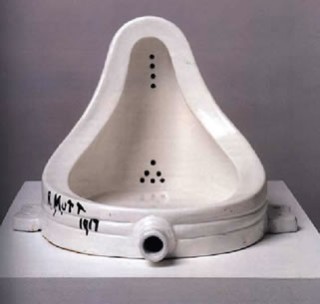
Pratone
Design: G. Ceretti, P. Derossi, R. Rosso
Date: 1971
Manufacturer: Gufram
Materials: Cold foamed polyurethane treated with green washble paint Guflac.
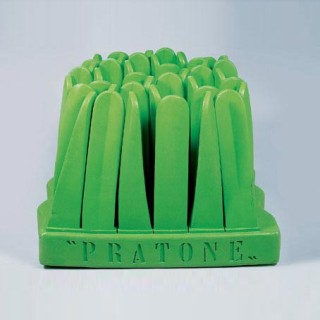
Joe sofa
Design: P. Lomazzi, D. D'Urbino, J. De Pas
Date: 1970
Manufacturer: Poltranova
Materials: Polyurethane covered in leather

Moloch floor lamp
Design: Gaetano Pesce
Date: 1970/71
Manufacturer: Bracciodiferro S.r.L.
Materials: Metal alloy shaft, steel base
Moloch XXL floor lamp was an enormous reproduction of the popular swing-arm Luxo L1 lamp by J. Jacobsen. A limited, numbered edition of only 20 were every produced.
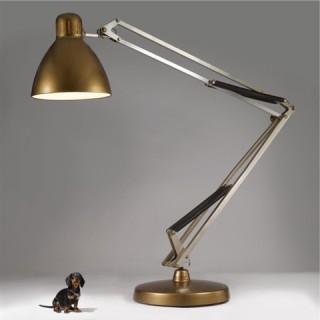
The first mirrors used by people were most likely pools of dark, still water, or water collected in a primitive vessel of some sort. The earliest manufactured mirrors were pieces of polished stone such as obsidian, a naturally occurring volcanic glass. Examples of obsidian mirrors found in Anatolia (modern-day Turkey) have been dated to around 6000 BC. Polished stone mirrors from central and south America date from around 2000 BC onwards.[1] Mirrors of polished copper were crafted in Mesopotamia from 4000 BC, and in ancient Egypt from around 3000 BC. In China, bronze mirrors were manufactured from around 2000 BC, some of the earliest bronze and copper examples being produced by the Qijia culture.
The typical mirror is a sheet of glass that is coated on its back with aluminum or silver that produces images by reflection. The mirrors used in Greco-Roman antiquity and throughout the European Middle Ages were simply slightly convex disks of metal, either bronze, tin, or silver, that reflected light off their highly polished surfaces. A method of backing a plate of flat glass with a thin sheet of reflecting metal came into widespread production in Venice during the 16th century; an amalgam of tin and mercury was the metal used. The chemical process of coating a glass surface with metallic silver was discovered by Justus von Liebig in 1835, and this advance inaugurated the modern techniques of mirror making. Present-day mirrors are made by sputtering a thin layer of molten aluminum or silver onto the back of a plate of glass in a vacuum. In mirrors used in telescopes and other optical instruments, the aluminum is evaporated onto the front surface of the glass rather than on the back, in order to eliminate faint reflections from the glass itself.
When light falls on a body some of the light may be reflected, some absorbed, and some transmitted through the body. In order for a smooth surface to act as a mirror, it must reflect as much of the light as possible and must transmit and absorb as little as possible. In order to reflect light rays without scattering or diffusing them, a mirror's surface must be perfectly smooth or its irregularities must be smaller than the wavelength of the light being reflected. (The wavelengths of visible light are on the order of 5 10-5 cm.) Mirrors may have plane or curved surfaces. A curved mirror is concave or convex depending on whether the reflecting surface faces toward the centre of curvature or away from it. Curved mirrors in ordinary usage have surfaces that are spherical, cylindrical, paraboloidal, ellipsoidal, and hyperboloidal. Spherical mirrors produce images that are magnified or reduced--exemplified, respectively, by mirrors for applying facial makeup and by rearview mirrors for automobiles. Cylindrical mirrors focus a parallel beam of light to a line focus. A paraboloidal mirror may be used to focus parallel rays to a real focus, as in a telescope mirror, or to produce a parallel beam from a source at its focus, as in a searchlight. An ellipsoidal mirror will reflect light from one of its two focal points to the other, and an object situated at the focus of a hyperboloidal mirror will have a virtual image.
Mirrors have a long history of use both as household objects and as objects of decoration. The earliest mirrors were hand mirrors; those large enough to reflect the whole body did not appear until the 1st century AD. Hand mirrors were adopted by the Celts from the Romans and by the end of the Middle Ages had become quite common throughout Europe, usually being made of silver, though sometimes of polished bronze.
The use of glass with a metallic backing commenced in the late 12th and early 13th centuries, and, by the time of the Renaissance, Nürnberg and Venice had established outstanding reputations as centres of mirror production. The mirrors produced in Venice were famous for their high quality. Despite the strictures of the doges, Venetian workmen succumbed to the temptation to carry the secrets of their craft to other cities, and, by the middle of the 17th century, mirror making was practiced extensively in London and Paris. Generally, mirrors were extremely expensive--especially the larger variety--and the wonderment created at the time by the royal palace at Versailles was due in part to the profusion of mirrors that adorned the state rooms.
From the late 17th century onward, mirrors--and their frames--played an increasingly important part in the decoration of rooms. The early frames were usually of ivory, silver, ebony, or tortoiseshell or were veneered with marquetry of walnut, olive, and laburnum. Needlework and bead frames were also to be found. Craftsmen such as Grinling Gibbons (1648-1721) often produced elaborately carved mirror frames to match a complete decorative ensemble. The tradition soon became established of incorporating a mirror into the space over the mantelpiece: many of the early versions of these mirrors, usually known as overmantels, were enclosed in glass frames. The architectural structure of which these mirrors formed a part became progressively more elaborate; designers such as the English brothers Robert and James Adam created fireplace units stretching from the hearth to the ceiling and depending largely for their effect on mirrors. On the whole, mirror frames reflected the general taste of the time and were often changed to accommodate alterations in taste, frames usually being cheaper and hence more easily replaced than the mirror itself. (See interior design, Adam, Robert.)
By the end of the 18th century, painted decoration largely supplanted carving on mirrors, the frames being decorated with floral patterns or classical ornaments. At the same time, the French started producing circular mirrors, usually surrounded by a Neoclassical gilt frame that sometimes supported candlesticks, which enjoyed great popularity well into the 19th century. Improved skill in mirror making also made possible the introduction of the cheval glass, a freestanding full-length mirror, supported on a frame with four feet. These were mainly used for dressing purposes, though occasionally they had a decorative function.
New, cheaper techniques of mirror production in the 19th century led to a great proliferation in their use. Not only were they incorporated into pieces of furniture, such as wardrobes and sideboards, but they were also used extensively in decorative schemes for public places.
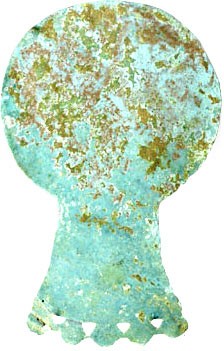
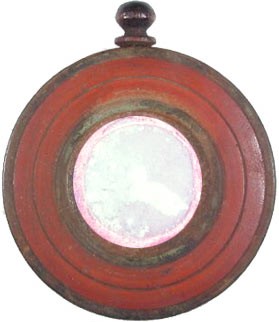
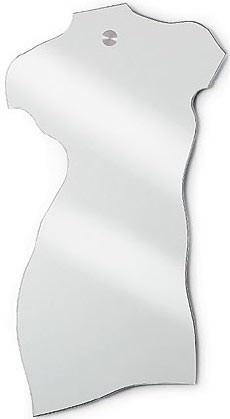
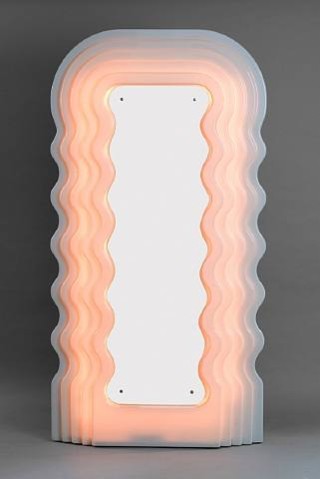
This wall mounted mirror is engineered to rotate and move on any axis and present a near perfect reflection. A lever and ball joint at the back of the mirror facilitates smooth movement and allows positioning at all angles reflecting any aspect or corner of an interior. Sophisticated compound curves are combined with precision injected moulded casing, die-cast aluminum fixings and an instrument grade mirrored glass lens. This is a very clear expression of quality and a unique, desirable design object. Convex mirror is available in anthracite (very dark grey) and 'Established & Sons' red.
Sun catcher
A CSP station consists of banks of several hundred giant mirrors that cover large areas of land, around a square kilometre. Each mirror's position can be carefully controlled to focus the sun's rays onto a central metal pillar that is filled with water. Prototype stations using this technique have already been tested in Spain and Algeria.
Once the sun's rays are focused on the pillar, temperatures inside start to soar to 800C. The water inside the pillar is vaporised into superhot steam which is channelled off and used to drive turbines which in turn generate electricity. 'It is proven technology,' added Knies. 'We have shown it works in our test plants.'
Scientists have struggled for years to make electricity from the sun's light at a cost competitive with power from coal or natural gas. The challenges are formidable. But now they are close, using the sun's heat instead.
Last month, Acciona Energy, a Spanish company, opened a solar thermal installation spread across 400 acres of desert outside Boulder City, Nev., 25 miles southwest of Las Vegas. Called Nevada Solar One, it has 47 miles of trough-shaped mirrors, lined up in rows. Producing 64 megawatts, it is many times larger than the largest photovoltaic installations, which use the cells that are found in everything from rooftop panels to pocket calculators.
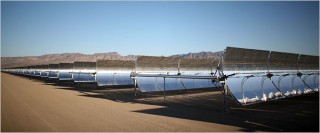
"Sun mirror"
A sun-deprived village in the Italian Alps has come up with a novel solution to fix the problem - by installing a giant mirror.
The mirror - an eight-by-five metre (26x16ft) sheet of steel - was placed on a nearby peak to reflect sunlight onto Viganella's main square below.
The computer-operated mirror will now be constantly following the sun's path.
Viganella sits at the bottom of a steep valley, and surrounding mountains cut off direct sunlight during the winter.
"We had to find the proper material, learn about the technology and especially find the money," he said. The project cost some 100,000 euros (£67,110) and was financed by the regional authorities and a bank.
'Like Siberia'
Viganella's problem is that it was built at the bottom of a very steep-sided Alpine valley, right up against the Swiss border.
The southern side of the valley is so sheer that on 11 November the sun disappears and does not reappear until 2 February. Not a single ray of sunlight falls on Viganella in the weeks in between.
"It's like Siberia," one of the village's nearly 200 residents has said.
However, the south-facing slopes to the north do get sunshine just a few hundred metres above the village. So the mirror was mounted on the mountainside to reflect sunlight into the village's main piazza.
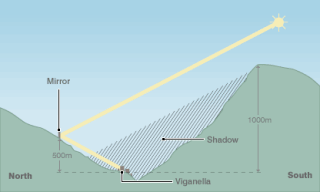
The mayor, Pierfranco Midali, worked with architect Giacomo Bonzani, to come up with a plan to bring the sun to Viganella: place a mirror high up on the northern slope to reflect sunlight down onto the town.
www.youtube.com/watch?v=s9aRTjfDFFI&feature=relatedThe humble mirror is probably the focus of more superstitions than any other object. These stories evolved from the times when water was used as a mirror. People would look into the water to see their fates. If the image was distorted it was a sure sign of the viewer's death. As the mirror changed form, so did the beliefs. Early people gazed into a mirror in the same way that someone might gaze into a crystal ball. He imagined he saw the image of his soul. If the mirror was shattered so was the soul, and the person would die. The seven year's bad luck seems to have evolved from the ancient Roman belief that it took seven years for life to renew itself. The Romans are also responsible for little known remedy useful for anyone who breaks a mirror - the only way to escape the seven year sentence is to bury the broken mirror pieces.
Snow White and the Seven Dwarfs
Written by Wilhelm Grimm & Jacob Grimm in 1857
Adapted for Cinema by Walt Disney
Directed by David Hand in 1937
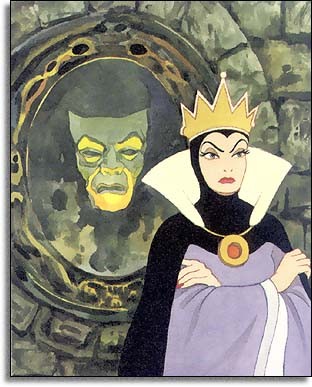
Narcissus or Narkissos (Greek: Νάρκισσος), possibly derived from ναρκη (narke) meaning "sleep, numbness," in Greek mythology was a hero from the territory of Thespiae in Boeotia who was renowned for his beauty. In the various stories he is exceptionally cruel, in that he disdains those who love him. As divine punishment he falls in love with a reflection in a pool, not realizing it was his own, and perishes there, not being able to leave the beauty of his own reflection.
